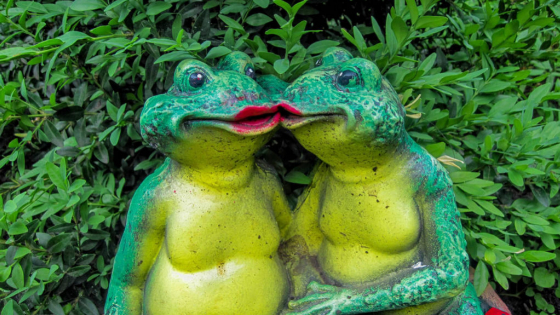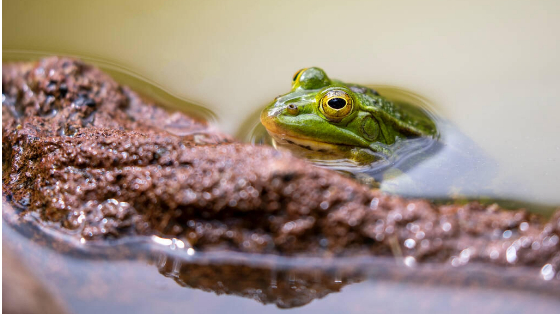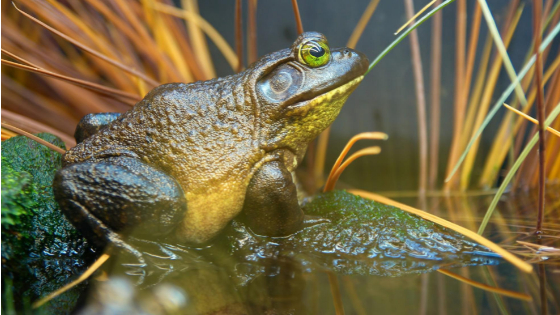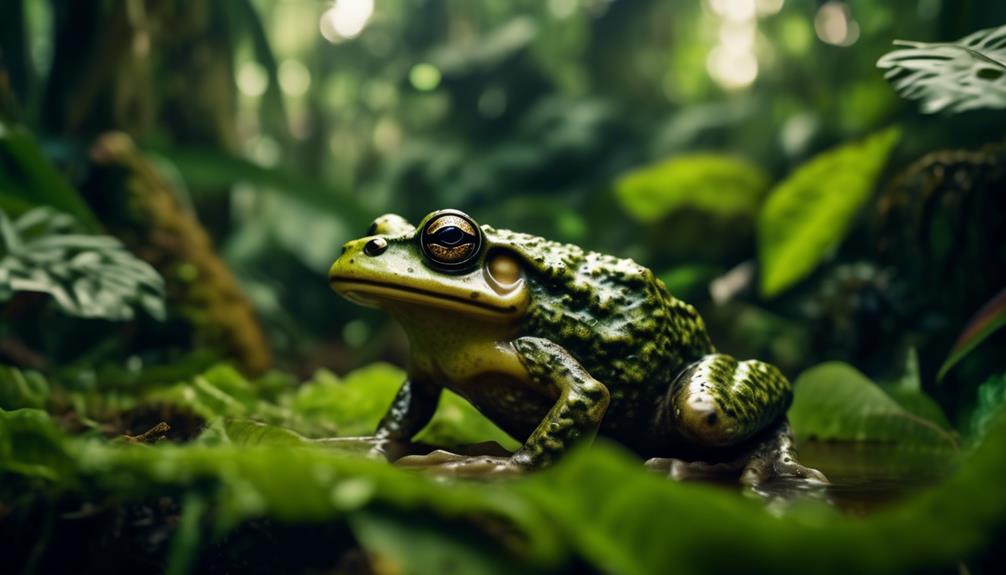
The future of massive Goliath frogs, renowned for their remarkable size and elusive nature, hangs in the balance as they confront a myriad of grave threats in their natural habitat.
These extraordinary amphibians, found in Equatorial Guinea and Cameroon, are facing a multitude of challenges that pose a significant risk to their survival. From the relentless pursuit by hunters seeking their flesh as a delicacy to the detrimental effects of habitat loss and degradation, the Goliath frogs’ plight is dire.
However, the full extent of their struggle and the urgent need for conservation measures go far beyond what meets the eye. As we explore the intricate details of their dietary preferences, reproductive behavior, and the impact of government regulations, we will uncover a story that not only unveils the perils faced by these majestic creatures but also sheds light on the crucial importance of collaborative efforts to safeguard their existence.
Key Takeaways
- Goliath frogs are primarily found near waterfalls in Equatorial Guinea and Cameroon, with a clear preference for water territories.
- The primary threat to Goliath frogs is hunting for food, leading to the need for conservation measures in cooperation with local communities.
- Goliath frogs are omnivorous, with a carnivorous preference, and prey on various terrestrial, aquatic, and semi-aquatic animals.
- Goliath frog nests play a crucial role in the reproduction and survival of their offspring by reducing predation and preventing eggs from being washed away.
Description and Habitat
The Goliath frog, known for its minimal sexual dimorphism, is a large amphibian species that inhabits the dense equatorial forest fringe parallel to the coast and is primarily found near waterfalls in Equatorial Guinea and Cameroon.
These frogs exhibit weights ranging between 600 and 3,250g (1.3 and 7.2lb), with snout-vent lengths ranging between 17 and 32cm (6.7 and 12.6in). Their eyes can reach a diameter of nearly 2.5cm (1.0in) and they possess a conspicuous tympanum with a diameter around 0.5cm (0.20in).
They are mainly found in the Sanaga Basin, Kienke Basin, Ntem Basin, and Mbía Basin, with a clear preference for water territories. Their habitat is divided into the dry season (November to April) and the rainy season (May to October).
Unfortunately, the primary threat to their survival is hunting for food. Conservation measures, in cooperation with local communities, are necessary to protect these remarkable amphibians.
Conservation Measures
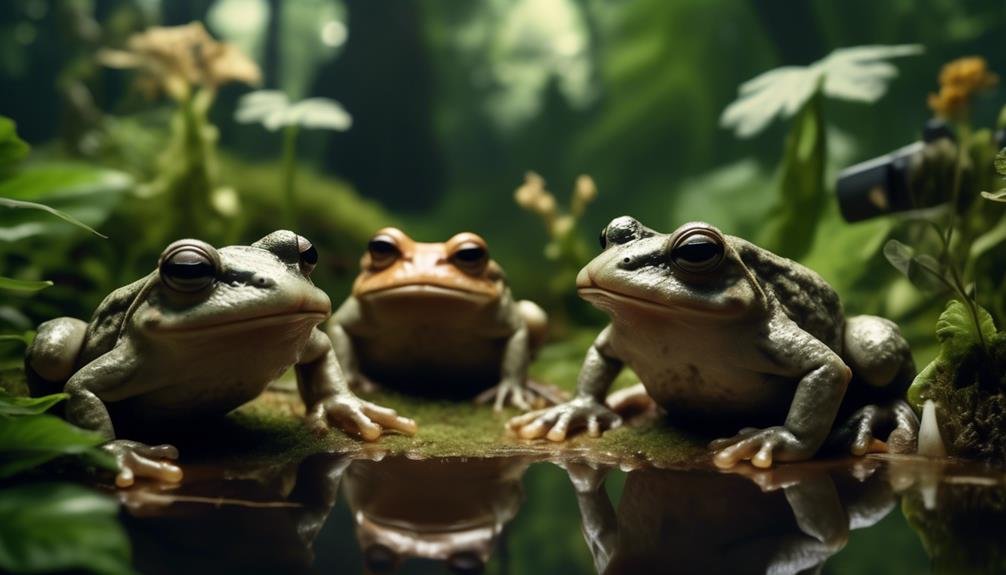
To ensure the long-term survival of the Goliath frog, effective conservation measures must be implemented in collaboration with local communities. Here are four key measures that can help protect these giant amphibians:
- Establish protected areas:
Creating designated reserves or protected areas where Goliath frogs can thrive undisturbed is crucial. These areas should encompass their natural habitats and be strictly enforced to prevent hunting and habitat destruction.
- Promote sustainable hunting practices:
Working closely with local communities, it is important to educate and promote sustainable hunting practices. This includes setting limits on the number of frogs that can be harvested, implementing seasonal hunting bans, and encouraging alternative sources of protein for local communities.
- Restore and protect habitats:
Efforts should be made to restore and protect the habitats of Goliath frogs. This can involve reforestation initiatives, monitoring and controlling invasive species, and implementing measures to reduce habitat degradation from activities such as logging and mining.
- Raise awareness and education:
Increasing awareness about the importance of Goliath frogs and their role in the ecosystem is crucial. This can be done through educational programs, community workshops, and public campaigns that highlight the need for conservation and the benefits of protecting these magnificent creatures.
Dietary Preferences and Reproduction
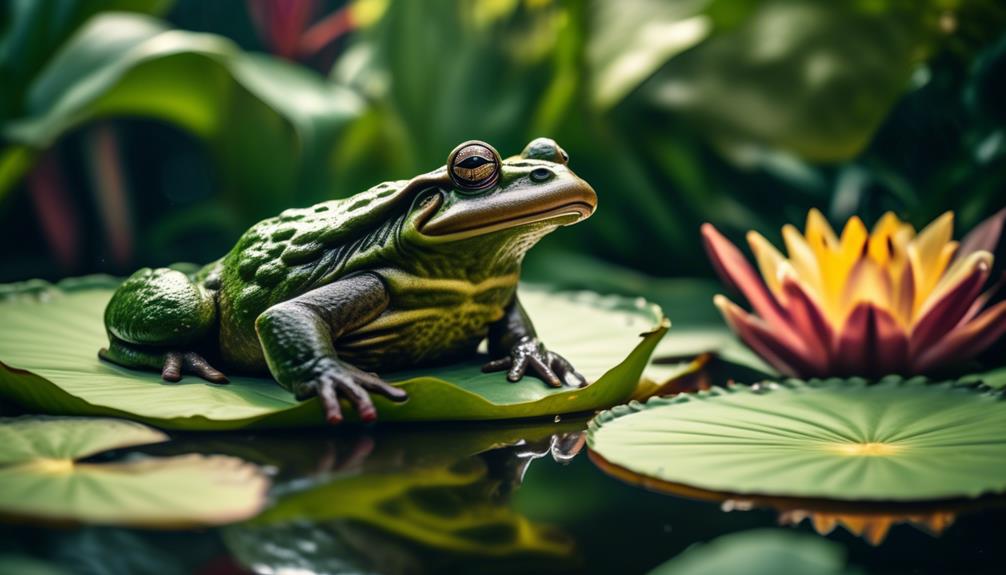
Goliath frogs exhibit distinct dietary preferences and reproductive behaviors. These massive amphibians are omnivorous, but they have a carnivorous preference, preying on a variety of terrestrial, aquatic, and semi-aquatic animals. Interestingly, their food preferences vary among different weight groups.
In terms of reproduction, water plays a vital role. Goliath frogs do not have vocal sacs and do not produce mating calls. Instead, they rely on egg masses consisting of several hundred to a few thousand eggs. The frogs construct three main types of nests for their offspring: clearing existing pools, expanding existing pools, or digging new pools. Larval development takes between 85 and 95 days.
Understanding the dietary preferences and reproductive behaviors of Goliath frogs is crucial for their conservation and management in the face of dire threats.
Life Cycle and Longevity
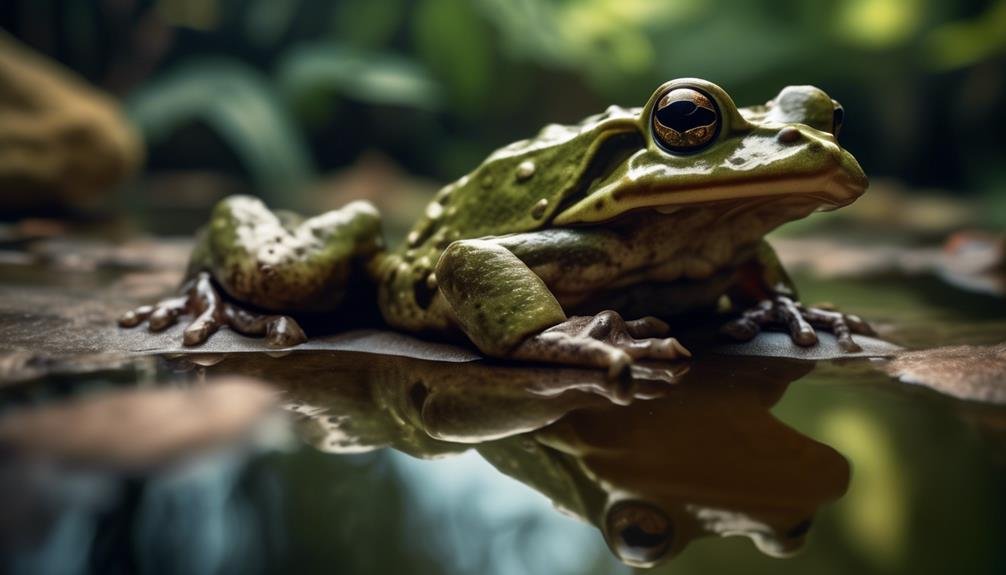
During their life cycle, Goliath frogs undergo significant developmental changes and can live for up to 15 years in the wild and 21 years in captivity. To understand the life cycle and longevity of these massive frogs, here are four key points:
- Developmental stages:
Goliath frogs start as eggs, with the cover of the egg mass turning yellow after 24 hours. In the first month, they have transparent external gills and no differentiated organs. By the second month, they show increased activity, pigmentation, and visible spiraculum and anal tube. In the third month, posterior legs start forming, and tadpole length is around 40mm. Finally, in the fourth month, they complete metamorphosis, their tail is reabsorbed, and they obtain their adult shape.
- Lifespan in the wild:
Goliath frogs can live for up to 15 years in their natural habitat. However, they face threats from predators such as snakes, Nile crocodiles, Nile monitors, and humans.
- Lifespan in captivity:
In captivity, Goliath frogs have been known to live even longer, with a lifespan of up to 21 years. This longer lifespan is attributed to the controlled environment, absence of predators, and proper care provided by humans.
- Threats to longevity:
Despite their potential for long lives, Goliath frogs face various threats that can reduce their lifespan. These threats include hunting for food, habitat loss, degradation, and diseases like chytridiomycosis caused by a fungus. Conservation measures and cooperation with local communities are crucial to protecting these unique creatures and ensuring their longevity.
Predators and Threats
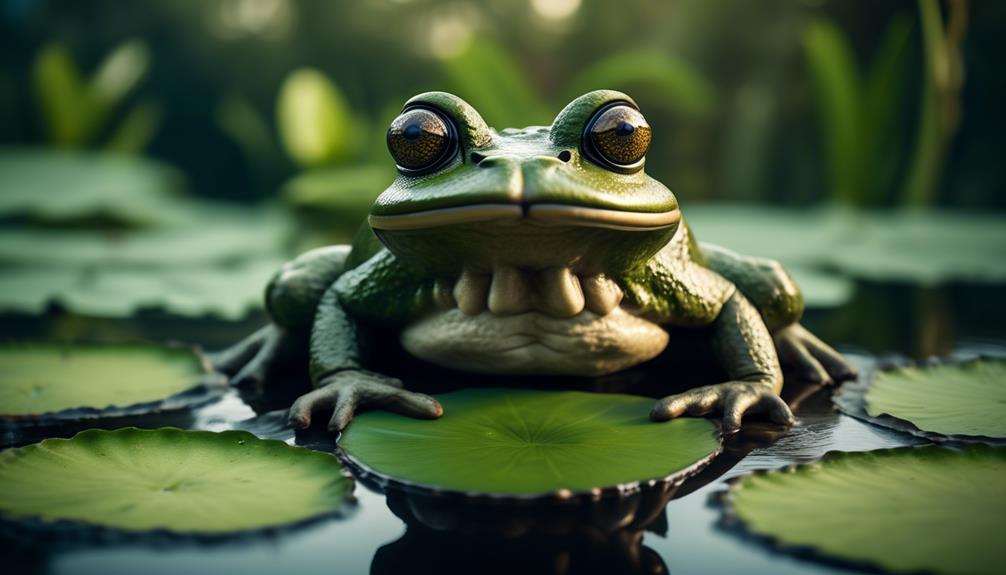
The survival of Goliath frogs is constantly threatened by a range of predators and external factors that pose significant risks to their population. Predators such as snakes, Nile crocodiles, Nile monitors, and humans prey upon these massive frogs. They are also susceptible to parasitic infections, particularly from the Icoseilla parasite, as well as the chytridiomycosis fungus.
Additionally, habitat loss and degradation further contribute to the threats faced by Goliath frogs. These factors, combined with their slow reproductive rate and limited ability to breed in captivity, make the conservation of this species crucial. Efforts must be made to address these threats and implement conservation measures in collaboration with local communities to ensure the long-term survival of the Goliath frog population.
Nest Construction and Its Significance
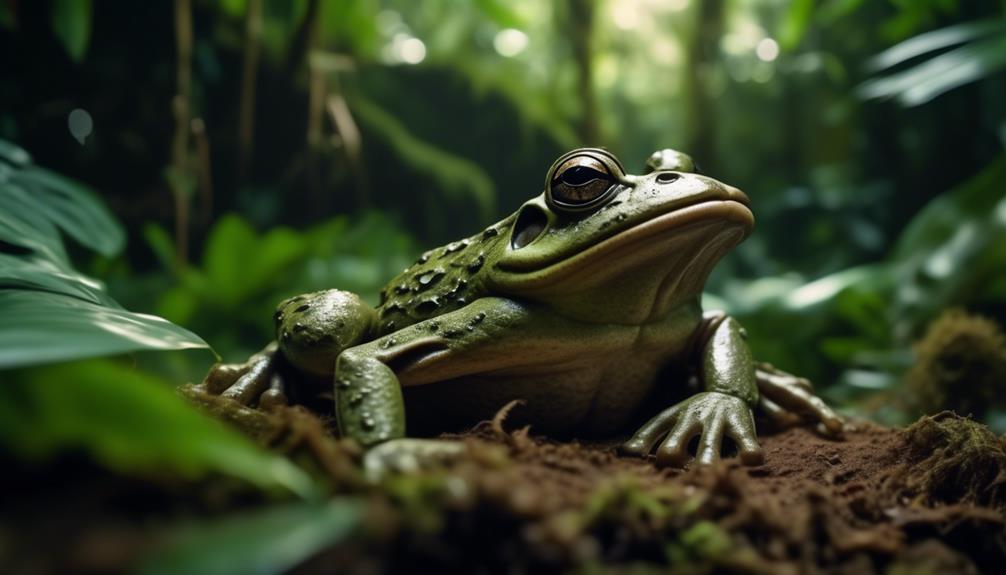
Predators and external factors pose significant risks to the population of Goliath frogs, making their nest construction and its significance crucial for their survival. Here are four key points about the nest construction of these massive frogs:
- Nest Types: Goliath frogs construct three main types of nests, including rock pools, existing washouts, and depressions in gravel riverbanks. These nests provide a secure environment for their offspring.
- Size Contribution: The construction of nests contributes to the overall size of Goliath frogs. The larger the nest, the more protection it offers against predators and the stronger the chances of successful reproduction.
- Predation Prevention: Nests play a vital role in reducing predation on Goliath frog eggs. By providing a safe haven, nests help protect the eggs from being eaten by snakes, Nile crocodiles, and other predators.
- Resisting Washout: Nests also serve the purpose of preventing the eggs from being washed away by the strong currents in their habitat. They offer stability and help ensure the survival of the developing embryos.
Through their nest construction, Goliath frogs demonstrate their adaptation to their environment and enhance the chances of their offspring’s survival.
Nesting Habits and Types
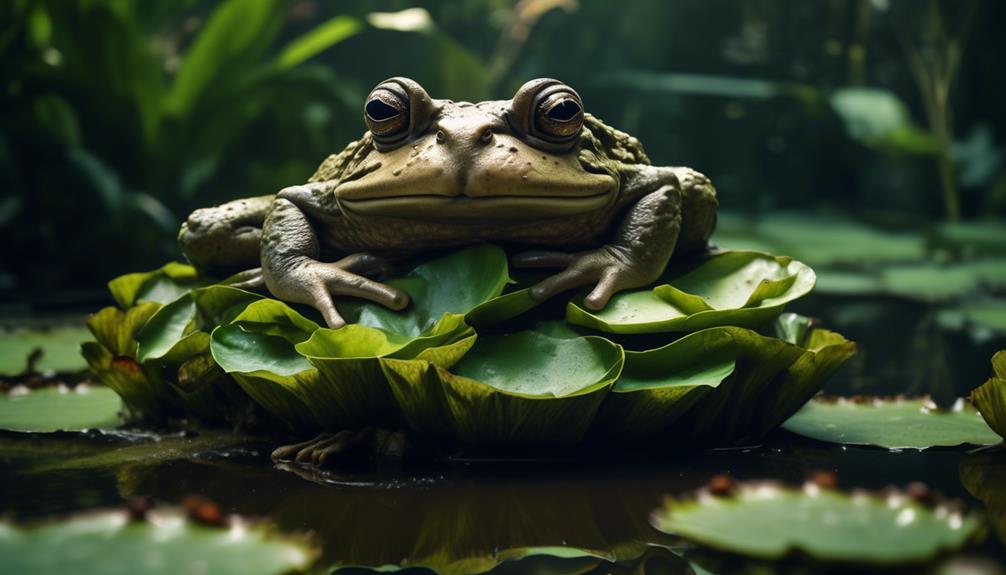
Goliath frogs exhibit specific nesting habits and construct various types of nests to ensure the survival and protection of their offspring. These frogs are known to create three main types of nests: rock pools, existing washouts, and depressions in gravel riverbanks. The construction of these nests is crucial to the reproductive success of the species.
The nests serve to reduce predation and prevent the eggs from being washed away by water currents. By choosing suitable nesting sites and constructing these nests, the goliath frogs are able to create a safe environment for their offspring to develop and grow.
However, despite their nesting efforts, the goliath frogs face numerous threats including parasites and the deadly fungal disease chytridiomycosis, which has resulted in a decline in their population.
Nesting Benefits for Offspring
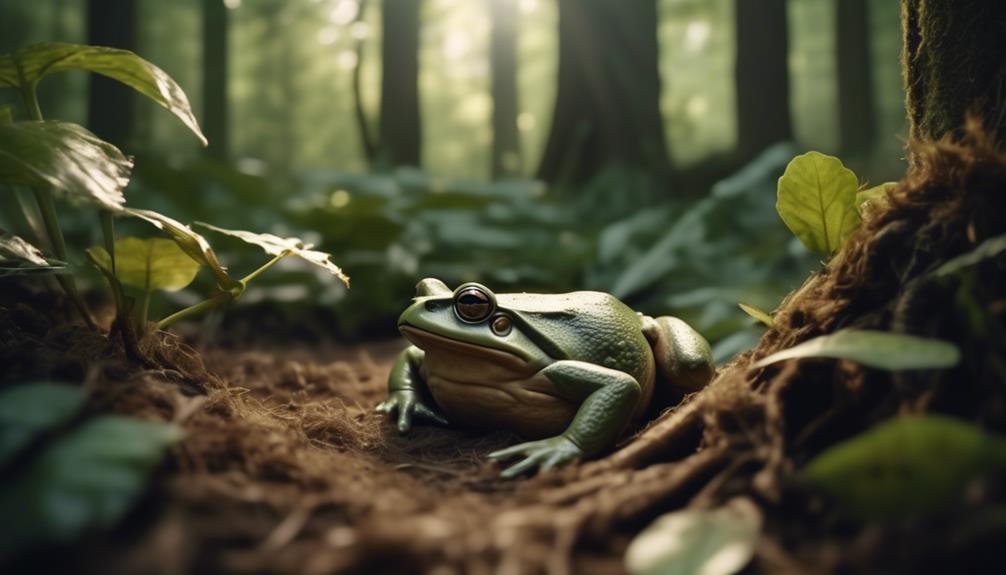
Nest construction by goliath frogs offers vital advantages for the development and protection of their offspring. Here are four benefits of nesting for goliath frog offspring:
1) Protection from predators: Nests provide a safe haven for the eggs and tadpoles, shielding them from potential predators such as snakes, Nile crocodiles, Nile monitors, and humans.
2) Prevention of egg loss: Nests help prevent the eggs from being washed away by strong currents, ensuring their survival and increasing the chances of successful hatching.
3) Optimal environmental conditions: By constructing nests, goliath frogs create microhabitats that offer suitable temperature and humidity levels, promoting optimal growth and development of their offspring.
4) Enhanced food availability: Nests often attract a variety of small invertebrates, providing a readily available food source for the growing tadpoles, leading to their improved nutrition and overall health.
Threats From Parasites and Disease
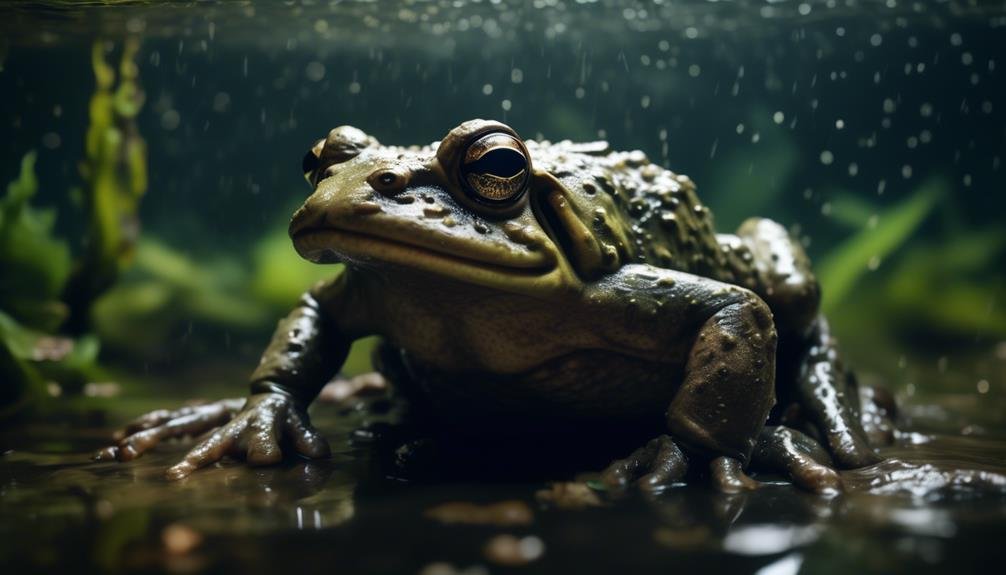
Parasites and diseases pose significant threats to the survival and well-being of goliath frogs. These massive amphibians already face challenges from habitat loss and hunting for food. However, the presence of parasites and diseases further exacerbates their vulnerability. One particular parasite that affects goliath frogs is Icoseilla, which can cause harm and weaken their immune systems. Additionally, goliath frogs are susceptible to chytridiomycosis, a fungal disease that has had devastating effects on amphibian populations worldwide. The combination of these threats puts the already endangered goliath frogs at even greater risk. To illustrate the impact of parasites and diseases on these magnificent creatures, the following table evokes an emotional response in the audience:
| Threat | Impact on Goliath Frogs |
|---|---|
| Parasites | Weakened immune systems |
| Diseases | Increased vulnerability and mortality |
| Icoseilla | Harm and potential long-term damage |
| Chytridiomycosis | Devastating effects on population |
It is crucial to address these threats and implement effective conservation measures to protect the goliath frogs from further decline.
Hunting Methods and Techniques
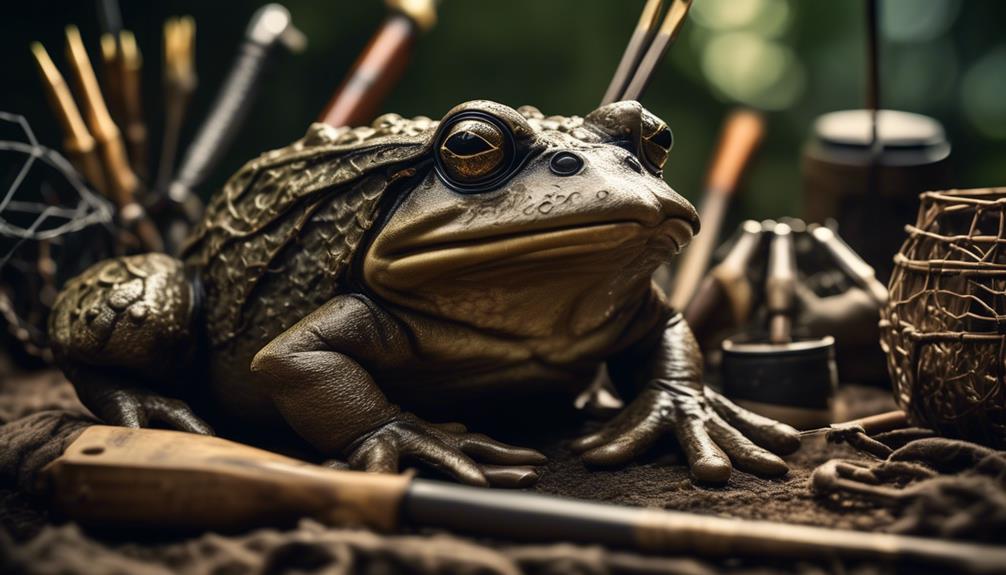
The hunting methods and techniques used to capture goliath frogs pose a serious threat to their survival and population numbers. These methods not only disrupt their natural behavior but also contribute to the decline of their population.
Here are four hunting methods and techniques that are detrimental to the goliath frogs:
- Lanterns: Hunters use lanterns to locate the frogs at night. The bright light disorients and attracts the frogs, making them easier targets.
- Mesh nets: Hunters use mesh nets to catch the frogs once they are located. The nets can cause injuries or even death to the frogs, especially if they get entangled.
- Trapping: Traps are set near the frogs’ habitats to capture them. This method can lead to the accidental capture of other non-targeted species, further impacting the ecosystem.
- Overexploitation: Due to their large size, goliath frogs are highly sought after for their meat. Overhunting can deplete their population and disrupt the balance within their ecosystem.
It is crucial to address these hunting methods and implement conservation measures to protect the goliath frogs from further decline.
Similar Species and Comparisons
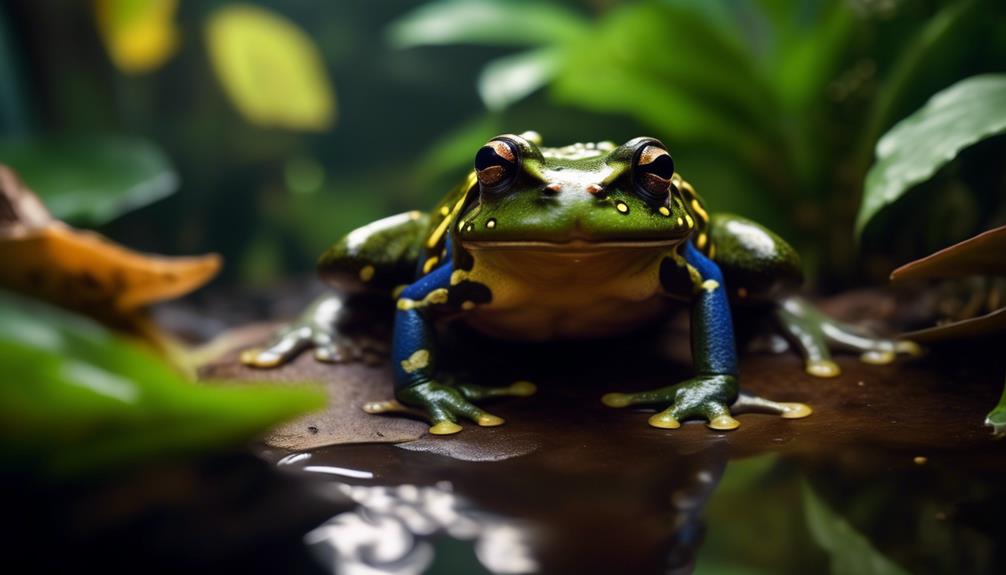
Some species closely resemble the goliath frog, presenting an opportunity for comparison and further exploration. Two such species are the Helmeted water toad and the Lake Junin giant frog. These species share certain similarities with the goliath frog, such as their large size and aquatic habitats. However, there are also notable differences between them.
| Species | Size | Habitat |
|---|---|---|
| Goliath Frog | Largest frog species | Near waterfalls |
| Helmeted water toad | Large, but smaller than goliath frog | Tropical rainforests |
| Lake Junin giant frog | Large, but smaller than goliath frog | Lake Junin, Peru |
While the goliath frog is known for its impressive size and unique habitat preferences, these similar species provide fascinating points of comparison in terms of size and habitat. Exploring the similarities and differences between these species can enhance our understanding of the biodiversity and adaptations within the frog family.
Government Regulations and Export Limits
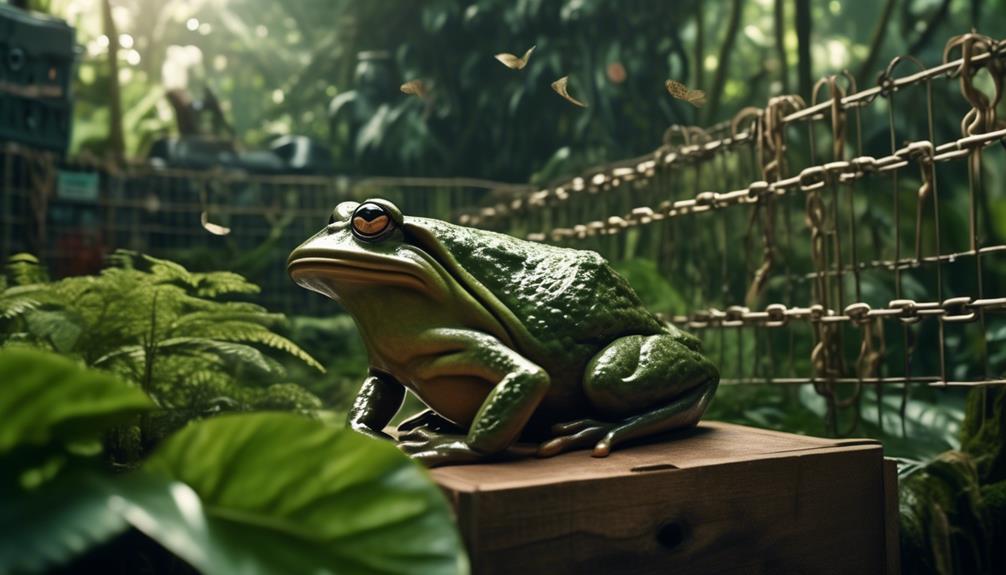
In order to ensure the conservation and protection of goliath frogs, government regulations and export limits have been implemented. These measures aim to mitigate the threats faced by these magnificent amphibians and maintain their population levels.
Here are four key points regarding government regulations and export limits for goliath frogs:
- Equatorial Guinean government limits export: The government of Equatorial Guinea has imposed restrictions on the export of goliath frogs, allowing only a maximum of 300 frogs to be exported each year.
- Conservation partnerships with local communities: The International Union for Conservation of Nature (IUCN) emphasizes the importance of collaboration with local communities to implement effective conservation measures for goliath frogs.
- Combating habitat loss and degradation: Alongside export limits, efforts are being made to address the threats of habitat loss and degradation, which pose significant risks to the survival of goliath frogs.
- Protection against hunting for food: One of the primary threats to goliath frogs is hunting for food. Government regulations aim to curb this activity and protect these frogs from overexploitation.
Urgency for Collaborative Conservation Efforts
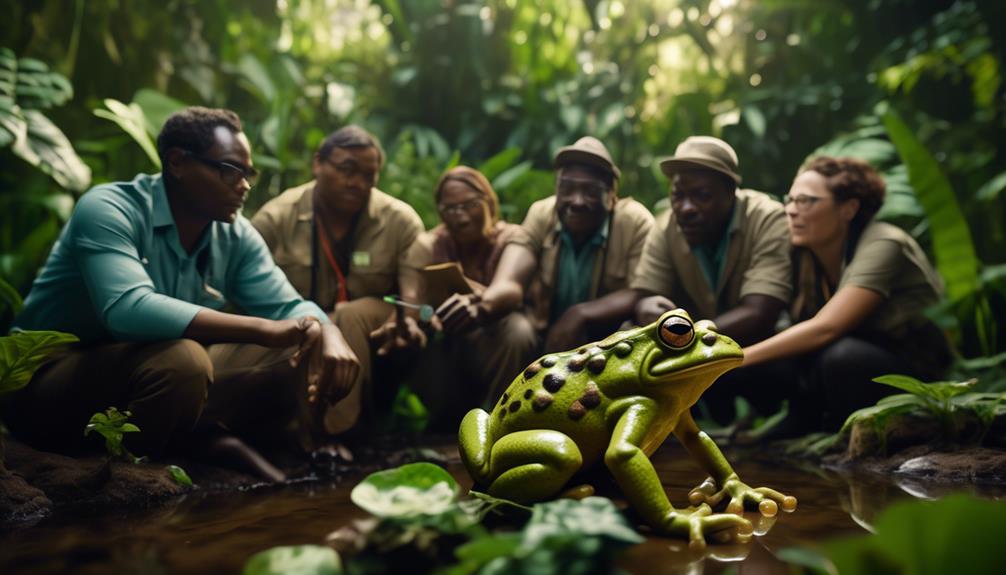
Collaborative conservation efforts are crucial to address the urgent need for protecting the endangered goliath frogs and ensuring their long-term survival.
The primary threat to these majestic creatures is hunting for food. To combat this, the International Union for Conservation of Nature (IUCN) emphasizes the importance of implementing conservation measures in cooperation with local communities.
Additionally, goliath frogs are also threatened by habitat loss and degradation. These frogs are shy and nervous in captivity, making breeding efforts challenging. The Equatorial Guinean government has implemented export limits, allowing only 300 goliath frogs to be exported per year.
Frequently Asked Questions
What Is the Average Lifespan of a Goliath Frog in the Wild?
The average lifespan of a Goliath frog in the wild is up to 15 years. These large frogs face threats such as hunting, habitat loss, and degradation. Conservation measures are needed to protect them in cooperation with local communities.
How Do Goliath Frogs Construct Their Nests?
Goliath frogs construct nests using three main types: rock pools, existing washouts, and depressions in gravel riverbanks. Nest construction contributes to their size and reduces predation, protecting eggs from being washed away.
What Are the Main Predators of Goliath Frogs?
The main predators of goliath frogs include snakes, Nile crocodiles, Nile monitors, and humans. These threats, along with parasites and disease, contribute to the dire situation facing these massive frogs.
Are Goliath Frogs Bred in Captivity?
Goliath frogs are not bred in captivity due to their shy and nervous behavior. Their primary threat is hunting for food, and they are also at risk from habitat loss and degradation. Conservation measures and cooperation with local communities are necessary for their protection.
What Are the Main Threats to Goliath Frogs Besides Hunting?
Besides hunting, the main threats to Goliath frogs include habitat loss and degradation. These frogs are also vulnerable to parasites and diseases, such as chytridiomycosis. Conservation measures, in cooperation with local communities, are crucial for their survival.
Are Goliath Frogs also at risk from predators like the Tomato Frogs’ defense mechanism?
Yes, Goliath Frogs are also at risk from predators like the terrifying tomato frog defense mechanism. Despite their large size, Goliath Frogs may still fall victim to predators, but they can rely on their own defensive tactics to stay safe in their natural habitat.
Conclusion
In conclusion, the massive Goliath frogs, or Conraua goliath, face dire threats to their survival due to hunting for food, habitat loss, and degradation. These impressive amphibians exhibit minimal sexual dimorphism and prefer water territories near waterfalls in Equatorial Guinea and Cameroon.
Conservation measures, including government regulations and export limitations, are crucial for their protection. Collaborative efforts with local communities are urgently needed to ensure the survival of these extraordinary creatures.

